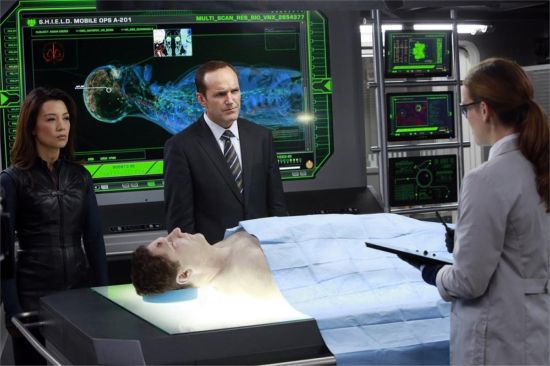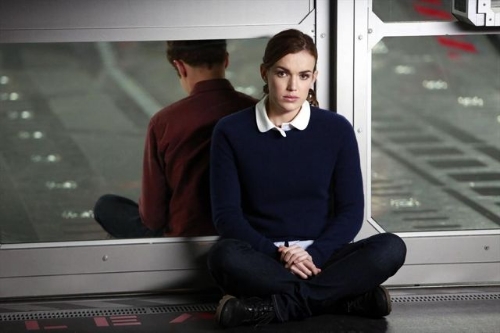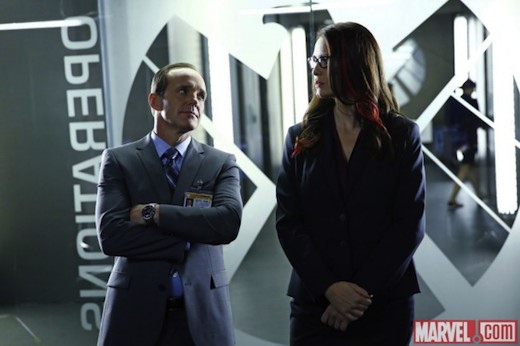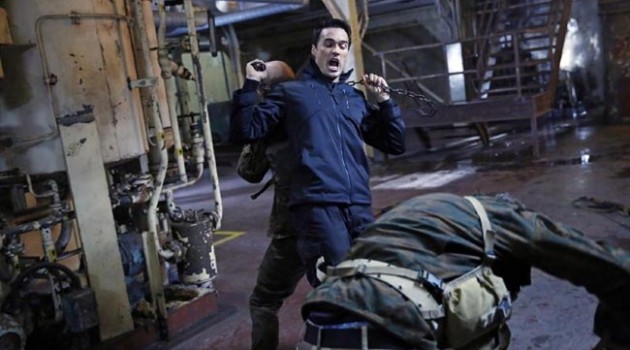Welcome back to our reviews of Marvel & ABC’s Agents of SHIELD. Agents took a few of weeks off, and so did we. As with every review so far, we’re keeping things as spoiler-free as possible. We’ll be looking at last week’s “FZZT”, which finally gives Simmons the chance to break out as a character in her own right, and this week’s “The Hub” which tries to do too much at once and ends up being kind of insubstantial.
First up is last week’s episode 6, “FZZT”. As far as I’m concerned, “FZZT” is a pretty good indication that the show seems to have finally found its legs. Like most shows that are predicated on a Problem-of-the-Week format, Agents has gone through a subtle evolution over the course of the season. It took four episodes for the writers find a tone that worked, and to get the cast to click within the PotW framework. Episodes 3 and 4 had plots that functioned like well-oiled machines, although to a very real extent, they could have been episodes of any paranormal investigative thriller (that’s a genre, right?) along the lines of X-Files or Fringe. Episode 5, meanwhile, “The Girl in the Flower Dress” was arguably the show’s first mythology episode, building on concepts from the pilot, and expanding upon the season’s Big Bad – a must for any mythology episode.
Following a certain pattern, “FZZT” delivers right on schedule with a plot where the Problem is secondary and the focus is given to deepening the characters and their relationships. This is a good thing, because Agents of S.H.I.E.L.D. has really needed to humanize its cast. For the first few episodes, the only really likeable castmembers have been Clark Gregg as team leader Agent Phil Coulson and Ming-Na as pilot/asskicker Agent Melinda “The Cavalry” May. Gregg has natural charisma, and given that he’s been inhabiting the role since 2008, he feels comfortable and familiar. Ming-Na, on the other hand, has been able to make the most of what should be a fairly unremarkable role.
But, oh, the rest of the team. To little effect, the writers attempted to connect us to Chloe Bennet’s Skye throughout most of the first episodes. Brett Dalton’s Agent Grant Ward seems to be intentionally difficult to like – the show’s made more than a few jokes at his expense over the last few episodes. That leaves Iain De Caestecker’s and Elizabeth Henstridge as the joined-at-the-hip science team FitzSimmons.
“FZZT” is about FitzSimmons’ relationship, and is primarily carried by Henstridge as Jemma Simmons. The team’s search for an elusive, electrical killer leads back to the events of Avengers and finds the team in a deadly race against the clock. The structure is fairly clever, in that it doesn’t actually kick into high gear until after the Problem of the Week is seemingly resolved, leading to one of my favorite moments of the series so far. We learn that things have gone horribly wrong not with some grand pronouncement, but with a sad look and an “I’m so sorry” from Coulson.
The entire team is in grave danger, but it’s Simmons at the center of the plot, and ultimately she’s under the most pressure. She’s forced to put her biomedical expertise to the test, alone, while Fitz and the rest of the team are left watching helplessly. More than once, the thrill of discovery (Simmons’ entire reason for being) is painfully twisted. The situation pushes Simmons past frustration, through despair, and to her breaking point.
It’s possible that the entire reason that Simmons was the focus of “FZZT” is that the show has established that she’s the biology specialist while Fitz is the tech guy. Had their specialties been reversed, this episode could have been largely the same with Fitz in the lead role. Regardless, it’s absolutely fantastic that we’re getting a full hour of TV that’s primarily dedicated a woman in a STEM field using actual science (or its TV equivalent) to solve a life-threatening problem through lab work. In fact, this episode is fairly unique among TV dramas in that there’s not a single punch thrown or shot fired.
From storytelling and character development perspective, the episode works pretty well and finally makes Simmons and, by extension, Fitz, seem human. It finally dawns on them that their work isn’t a game, and that there’s actual stakes. Their usual sci-fi babble chattering gives way to actual characters with real talent and real problem-solving skills. It’s a wonderful step forward in making the pair seem less like cartoons, and with any luck, we’ll see similar depth in future character-centric episodes.
This Tuesday’s episode, “The Hub” begins with an exceptionally silly spy-fi pastiche cold open that raised fears of yet another episode set in a cartoonish, stereotyped version of another country. And, yes, the team does spend some time in the Caucasus Mountains, but it’s far from being the main focus of the plot. Instead, we get a field trip to S.H.I.E.L.D.’s slightly-less-super-secret spy base, The Hub. It seems they’re saving the super-duper-secret base, the Triskelion, for the films. It’s all chrome, steel, high-tech architecture and people with badges wearing smart suits.
Foremost among these well-dressed men and women is Agent Victoria Hand, a character from the Marvel Comics who is best known for being a horrible, horrible person. She’s not much nicer here, co-opting Grant and Fitz for some ill-defined secret mission, putting a gag order on Coulson and May, and leaving Simmons and Skye fretting and powerless. (At least until Skye drags Simmons into her usual rules-flaunting shenanigans – which Simmons is comically terrible at, but which inevitably save the day.)
“The Hub” ultimately ends up being kind of a trifle, lacking the character development of “FZZT” or the fun, intricate plots of “The Asset” or “Eye-Spy”. The primary plot is extremely formulaic and predictable. S.H.I.E.L.D. gets up to something shady, Skye breaks the rules, Coulson finds his conscience and saves the day. There’s really nothing to spoil. It exists solely as a framework on which to hang character and overarching story bullet points that the writers seemed intent on checking off.
On the one hand, it functions as a follow-up to “FZZT” in that a lot of Grant and Fitz’s arc during the episode involves dealing with the emotional fallout from the end of the prior episode. On the other hand, S.H.I.E.L.D. is established as a big, scary, amoral spy organization that doesn’t always has the best interests of its operatives at heart, something we didn’t see in Avengers (or even on this show so far). But we know from having seen the Captain America: The Winter Soldier trailer that S.H.I.E.L.D. doesn’t always play nice. Perhaps it’s the show’s way of hammering home that Coulson’s team are mavericks, or it could be that they’re trying to set up an ethically grey S.H.I.E.L.D. for use later in the series and in future films.
“The Hub” is not a terrible episode. It’s not a step back, nor is it really poorly made. It’s just that it’s a transitional episode, building on character relationships and furthering some of the season’s overall plot threads while giving viewers some mild espionage thrills and a few decent little moments. With its paint-by-numbers plot and superficial character development, it’s the opposite of a must watch. On the bright side, the fact that it lacks substance does mean that while it doesn’t soar like some past episodes, it’s nowhere near as offensive or scientifically questionable as it could be.





